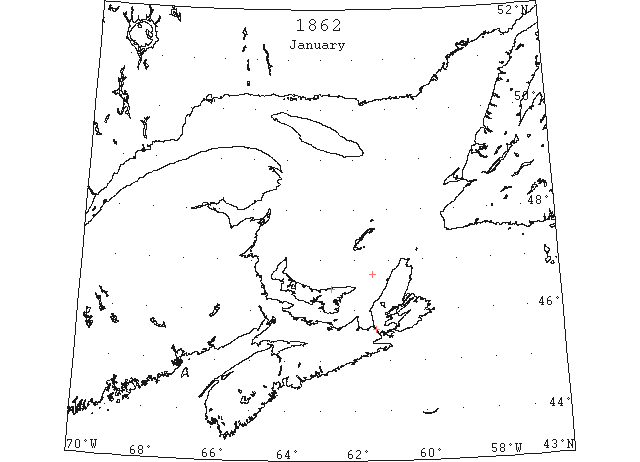
Jan 12 Halifax, vessel abandoned, picked up drifting in the ice through the Strait of Canso on the morning of the 12th inst., a small vessel, probably about 15 tons, with the name on the stern, “Spy” of P E Island. Masts were broken off close to the deck and left on board; no sails, anchors or rigging of any sort having been taken off. She was boarded by two boats and crew from the Cape Breton shore and after a great deal of exertion and labor, they succeeded in getting her through the ice, which was very thick in the Strait, and hauled her on shore in a place of safety – the full being uninjured. (AR 25/01/1862 p3 #3)
Jan 20 Mr. Alexander Chiverie writing from Souris to his brother in town, states that on the North Side, last week , 18 barrels butter, and also some cheese, were picked up; and that three dead bodies were seen in the lolly ice – one with the head off – but they could not be got at. The exact spot is not given where they were seen, but it is somewhere between St. Peter’s and East Point. There was no appearance of any vessel to which the unfortunate men might have belonged. It is supposed that the vessel in which they were came from somewhere in the St. Lawrence, struck the ice in the Gulf, and the men placed the articles found upon it to protect themselves from the winds; and that they drifted on shore upon the ice, which was broken by the force of the surf, and the men precipitated into the lolly. Ross’s Weekly. (Ex 20 Jan p3#3)
Jan 25 Halifax, the schr “Leader,” of P E Island, was blown out from the island with no one on board. When in the ice off Cape Negr? [unknown locality] she was stripped of chains, rigging and sails. The masts were cut away. Vessel floated to the Strait of Canso and is now in Emery Cove, uninjured by the elements. (AR 25/01/1862 p3 #2)
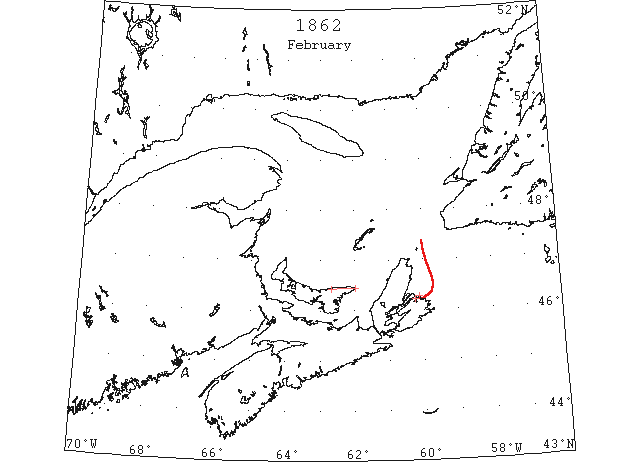
Feb 5 Mr. Donald McDonald writes us from St. Peter’s Bay that on the 5th of Feb people at the East Point observed a field of ice approaching, dotted with black specks. When the ice reached the shore the “specks” were discovered to be seals, and the inhabitants turned out and succeeded in capturing forty of them, 4 of which weighed 700 lbs. Since the above was written we learn that hundreds of seals were all along the North Side, and that in addition to those that were killed and secured, a great quantity might have been taken, had not the ice begun to part from the shore, thus endangering those engaged in the chance sealing. (Ex 17 Feb p3#3)
Feb 7 Halifax: SS “Adriatic” frozen in at Sydney. (LL)
Feb 8 Halifax, the steamer “Adriatic,” is reported by telegraph, frozen at North Sydney. (AR 08/02/1862 p3 #4)
Feb 15 The steamer “Ospray” arrived from Nfld. at Halifax on Saturday afternoon. She reports the coast at St. John’s clear of ice. She reports – saw little but little [ice] on the passage. (CB News 15/02/1862 p3 #1)
Feb 22 Halifax, the Steamship “Adriatic” is at present bound hard and fast in the ice at N. Sydney. A northerly wind drove a large mass of floating drift ice into the harbor, which, during the cold nights of the past 10 days became united form shore to shore, preventing either the ingress or egress of vessels no matter how powerful their agencies for cutting through ordinary heavy formed river ice. As in the case of the “Adriatic”. It was unfortunate affair sending so valuable and expensive ship to Sydney, during the present month, when past experience should have instructed the most venturesome that it was almost certain to be ice bound here. April escape. (AR 22/02/1862 p3 #3)
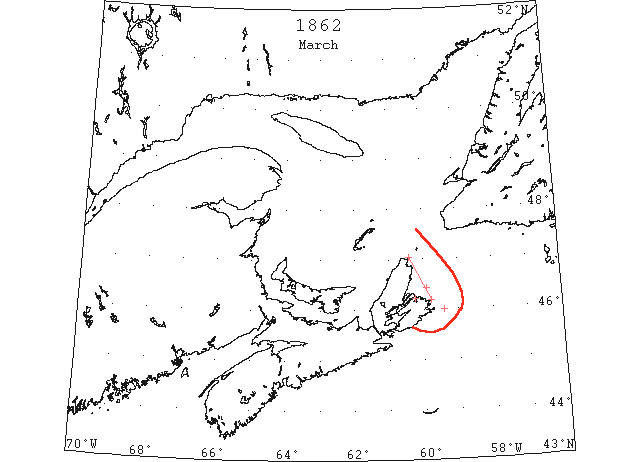
Mar 1 SS “Adriatic” left Sydney for England but put back with floats and stern damaged by ice. (LL)
Mar 2 Area of ice is extensive, although there are not very heavy masses of it. (CB News 22/03/1862 p3 #2)
Mar 8 Halifax, arrived, French schr “Henrietta,” St. Pierre 7 days in the ice off Scatterie. (AR 08/03/1862 p3 #3)
Mar? 8 The steamship “Adriatic” has been frozen in at Sydney, CB for the past two weeks, costs the British Government £1000 sterling per month. (AR 08/02[?]/1862 p3 #2)
Mar? 8 The harbour of Sydney, CB is now entirely clear of ice, and a the beginning of the week vessels were passing through the Strait of Canso. (AR 08/02[?]/1862 p3 #2)
Mar 9 SS “Plantagenet” from Liverpool to New York passed large quantities of field ice and several bergs from Flemish Cap to Cape Breton Is. (LL)
Mar 15 Steamship “Adriatic” has not yet been able to get to sea on her homeward voyage owing to the drift ice, which remains close on the shore – detained there by prevailing easterly winds. There has been no opening through it, north of Flint Island. (CB News 15/03/1862 p3 #3)
Mar 15 The streamship “Adriatic” is still in port, she having failed, in her attempt to proceed to sea on Saturday last, to get clear of drift ice which now encircles our shores, and returned to her moorings, after steaming as far as Flint Island Light – where she found the ice was too heavy and packed to admit her passing through it. A passage way of some length had been previously cut in the harbor ice by residents at the North Bar, under contract with the Admiralty Agent on board, with the almost certain hope that the obstruction of drift ice, outside had been removed by the Southerly gale of the proceeding Tuesday carrying it well to the Northward. The contrary proved to be the fact, upon trial as above stated. (AR 15/03/1862 p3 #3)
Mar 29 The SS “Adriatic” still remains frozen in at Sydney, CB. (AR 29/03/1862 p3 #3)
Mar 29 The schr “Matilda Hopewell,” Clements master, let Halifax March 25th for St. John’s, NF. On 29th fell in with large quantities of ice 150 miles SW Cape Race – had to go to the East as far as 51°06’W 46°85[?]’N (AR 19/04/1862 p3 #2)
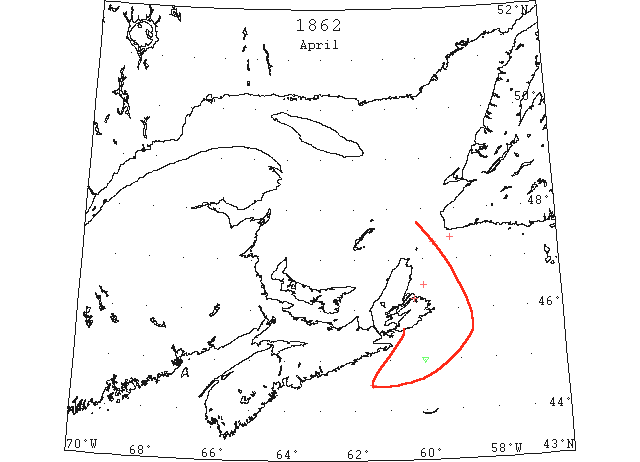
Apr 12 The drift ice still holds possession of the eastern sea-board, entirely preventing the arrival at or departures of vessel from the Port of N. Sydney. The harbor ice is still good for traveling over, either with horses or on foot. The steamship “Adriatic” remains here waiting a change of wind to drive the ice off our coast. (AR 12/04/1862 p3 #2)
Apr 21 SS “Adriatic” arrived Halifax from Sydney where she had been frozen in. (LL)
Apr 24 The transport SS “Adriatic” has been detained at Sydney CB for some time by the ice, are at this port on Sunday. (AR 26/04/1862 p3 #3)
Apr 27 Halifax, Capt. Morrison, of the bark “Gillilema,” at this port on Tuesday from London, reports haven fallen in with great quantities of ice on the 27th and 28th last. When between Sable Island and Cape Breton he saw as many as 12 at once, of the largest sized bergs, some of them being much higher than ship’s trucks. These, without doubt, are drifts from NF coast of Labrador. (AR 03/05/1862 p3 #3)
Apr 27-28 “Scotia” from London to Halifax fell in with great quantities of ice between Sable Is. and Cape Breton. (LL)
Apr 29 Port au Basque, plenty of ice to the south; not likely to be any between here [Halifax] and Scatterie. (AR 03/05/1862 p3 #3)
Apr 30 A large steamer passing in Cabot Strait. (GR p.31&33)
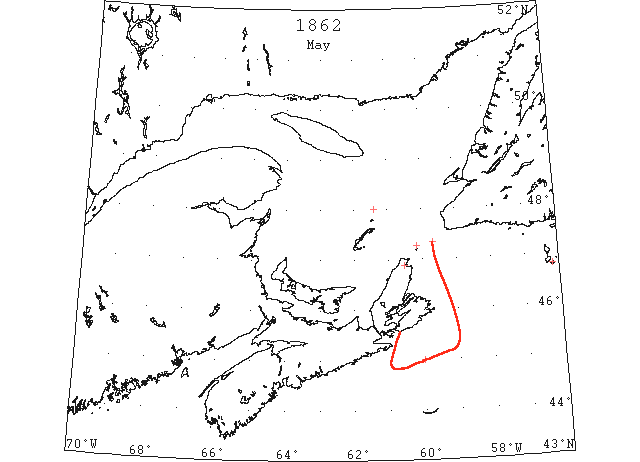
May 1 Halifax, the schr “Emblem,” at this port, passed large quantities of ice 3 days after leaving Port aux Basque, and saw two or three lofty bergs. (AR 01/05/1862 p3 #2)
May 4 “Helebroke” [?]’ from London to Montreal passed a quantity of field ice off St. Paul’s Is. and was detained 4 days NW of the Bird Rocks by heavy packed ice and fog; 10 sail in company at the time. (LL).
May 5 Ice very heavy off Cape North and St. Paul’s Is. (LL).
May 6-8 Heavy ice in the mouth of the gulf. (LL).
May 10 The ice was off St. Pierre, probably western ice? (GR p.33&35)